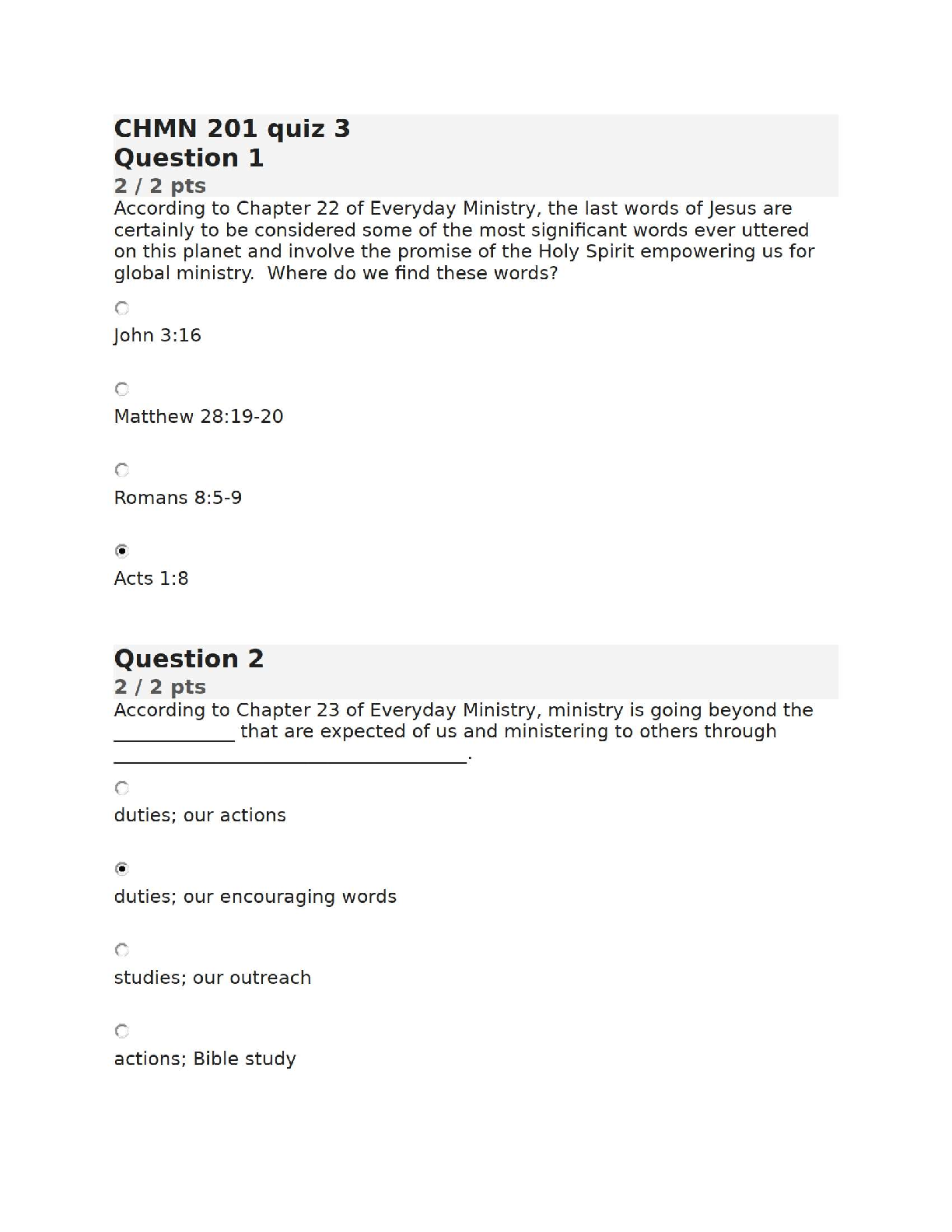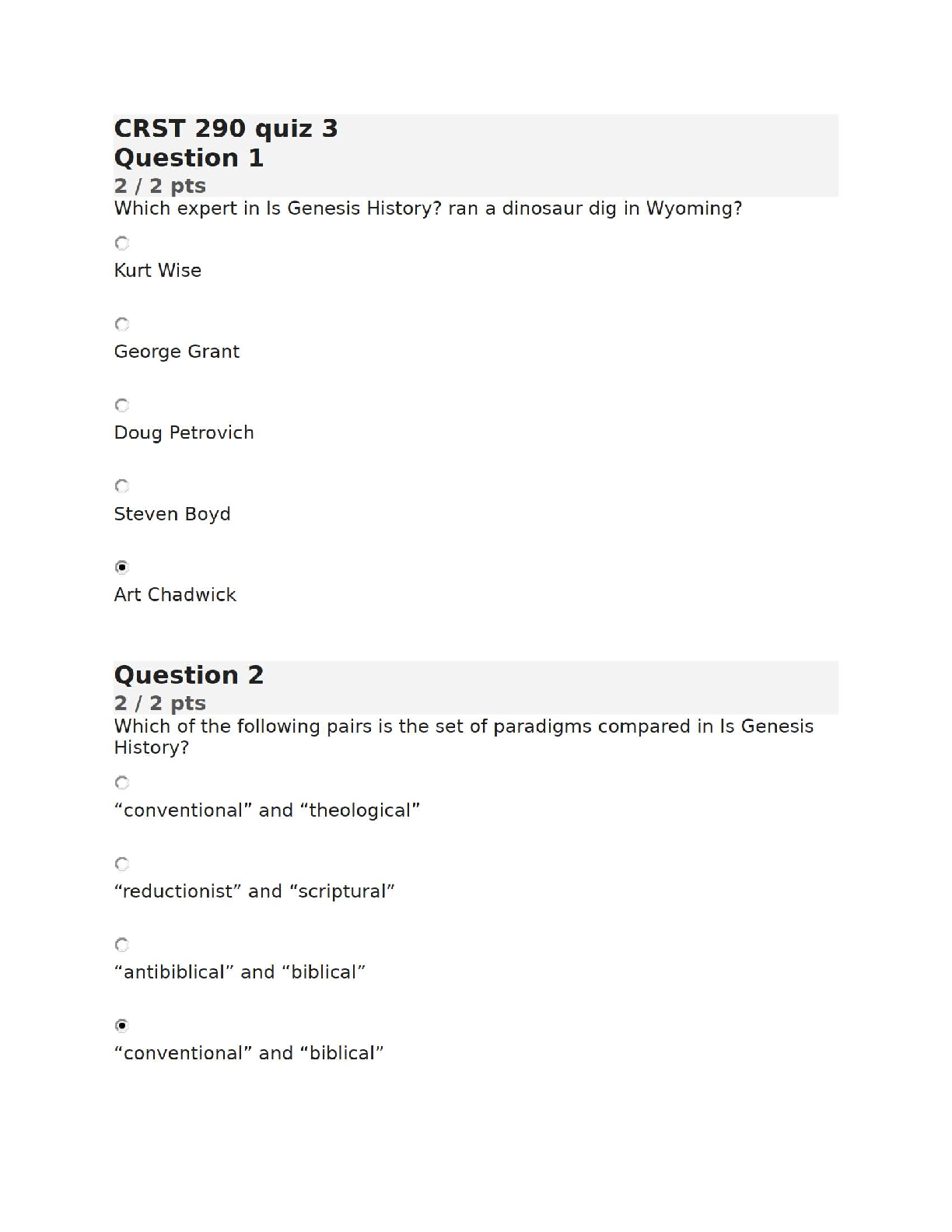BIOL 101 Quiz 3 | Complete Latest Q&A 2025.
Document Content and Description Below
BIOL101 QUIZ 3 6 Energy-Driven Inventions 6.1 Living Systems Require a Flow of Energy In a phrase, how do physicists define “energy”? Ability to do work The physicist’s definiti... on of energy is not ____________ __________ for use in defining energy changes within a living cell. Comprehensive enough How would a cell biologist define “energy”? The ability to make specific changed occur List 5 major sorts or categories of energy change within the cell. Fig 6.2. Biosynthesis- movement- concentration – electrical potential- heat Sometimes the cell pumps substances against diffusion forces that would otherwise carry those substances the other way. What term/phrase would we give to this pumping process? _____________ ___ _______________ Energy of concentration On a cold day, which of the following processes do your cells depend on to maintain an operating temperature of 37 degrees Celsius? a. muscle contraction b. shivering c. respiration energy production d. metabolic heat generation e. all of the above e 6.2 Laws of Energy Flow in the Living World ______ is freely convertible from one form to another but _______ can never be created or destroyed in normal processes. Energy (That means that in nature, as energy freely changes from one form to another, the total amount of energy stays constant.) Thus, a lit match cannot continue to burn when the wood of the match stick is consumed. This statement illustrates what general law of energy flow? Law of conservation of matter & energy Systems that convert energy from one form to another are not 100% efficient, thus the amount of useful energy ___________. decreases This is because, in cars and in living things, energy conversion is inefficient, with much energy being lost in the form of useless _______. Fig 6.4 Heat energy So, when your car engine burns the octane in gasoline, in what form does at least 50% of the energy of the octane end up? Heat energy In a crowded, unventilated room, what causes the temperature to rise? glucose What form of energy do producers use when they set about to generate chemical energy—the energy of C―H and C―O―H bonds? solar Thus, a producer organism is called a “producer” because it converts solar energy to usable ______ _______. Fig 6.5 “Energy In” Cemical energy 6.3 Energy Flows in Chemical Reactions Existing chemical bonds between atoms are broken and new ones are formed between different atoms. In the broadest sense this is the definition for a __________ _________. Chemical reactions Write out an example of a chemical reaction using names and symbols of reactants and products with an arrow between them. Whenever chemical bonds are broken, energy is __________. Whenever chemical bonds form, energy is __________. (Characteristic #1) Required Does an endergonic reaction require the input of energy, or does it give off energy? (Characteristic #1) Free energy must be added What term is given to the amount of energy required to break the bonds in reactant molecules? (Characteristic #3, Fig 6.6) Activation energy What is true of the bonds in reactant molecules that keeps most chemical reactions from occurring in nature? Their energy level is _______ than the activation energy necessary to break them. (Characteristic #3) Prohibitively high When ________ energy is not available for a given chemical reaction, the reaction will not go. (Characteristic #3) activation 6.4 Enzymes Direct Energy Flow How is the activation energy of desired reactions lowered in living things, so that the desired reactions are able to go forward? (Fig. 6.7) By putting stress on the bond that needs breaking What words best describe the way in which enzymes bind to reactant molecules? (second paragraph) The active site is highly __________ for the specific _________ of the reactant molecule. Active-site What exactly does an enzyme do to the chemical bonds within the reactant molecule? (second paragraph) Catalize chem reactions By binding to reactant molecules, what effect does an enzyme have on the activation energy for a given reaction? Fig 6.7 Catalyzes, increases 6.5 Energy Flow in Reaction Pathways: Metabolism What name do we give to sequences of chemical reactions within cells? Metabolic pathway In a ________ __________, the product of one reaction becomes the reactant of the next reaction and so on. Fig. 6.9 “ If the final end product of a metabolic pathway is continually removed and used elsewhere then the reactions of the entire pathway will be pulled in the direction of making more of the _____ ____________. (third paragraph) End product An allosteric enzyme has a second binding site other than its own active site for converting substrate to product. What does this second site bind to? (fourth paragraph) Fig 6.10 Regulatory molecules Suppose an excess amount of product accumulates at the end of a metabolic pathway. The product then binds to the allosteric site of the first enzyme along the pathway shutting down the pathway. What do we call this regulatory process? (fourth paragraph) Fig 6.11 Feedback inhibitation A single regulatory molecule can shut down multiple metabolic pathways if it is able to add _________ groups that alter the active site of the first enzyme in each pathway. (last paragraph) Fig 6.12 phosphate 6.6 Energy Pools in the Cell: ATP Energy-releasing reactions drive biosynthetic ones forward by contributing to a pool of _____ molecules. (second paragraph) Fig 6.13a Energy storage The substance _______ would most likely enable a flagellum to drive a bacterium forward through the medium in which it is swimming? Fig 6.13a Cellular atp Three phosphate groups linked to a ribose sugar which, in turn, is linked to a pyrimidine base known as adenine: This phrase describes the structure of _______. Fig 6.13b Adenosine triphosphate Where, in the ATP molecule is the “high energy” bond that carries potential energy and is easily broken? (third paragraph) Fig 6.13b figure legend. Ast two phosphates To derive energy from an ATP molecule, a small amount of (activation) energy must be added to break that last bond. But the new bonds that form in the reaction give off far more energy than was needed to break the bond in ATP. The whole process is nicely exergonic. This item (to the left) is just some summary chemistry that helps you to understand the item above it. 6.7 Energy Flow from Carbohydrates to ATP: Respiration In respiration, chemical energy is transferred from glucose to ATP. The energy transfer however, is not 100% efficient. In the transfer, some of the energy is lost as _______, (Review Section 6.2 above) Body heat See Figure 6.14. In what major cellular process are 3 interrelated, exergonic pathways (shown in blue) and oxygen used to generate large amounts of ATP from glucose molecules? respiration The term ___________________ could be defined as about 30 individual, sequential chemical reactions that form three metabolic pathways: one in the cytoplasm and two within the mitochondrion. Aerobic respiration List the reactants and products of the summary reaction for aerobic respiration. Fig. 6.15 Write out the summary reaction for aerobic respiration. Fig 6.15 6 oxyen + glucose > 6 h2o + 6 carbon dioxide + energy Name the 3 stages of aerobic respiration. Fig 6.14 (in blue) Glycolysis, kreb’s cycle, electron transfer phosphoryition The three metabolic pathways that make up aerobic respiration are really all parts of one larger pathway because the products of early pathways (like NADH) become _______ in the last one. Fig 6.14 (follow the arrows) Captured & spent Aerobic Respiration: Stage 1 – Glycolysis What is the first stage of aerobic respiration? Fig. 6.14 glycolysis Glycolysis is valuable to a cell because it supplies minimal energy without requiring the presence of __________ as a reactant. (early in paragraph) oxygen In the process of glycolysis one 6-carbon molecule of _______ is converted to two 3-carbon molecules of __________. (mid-paragraph) Glucose-pyruvate Therefore: Is carbon dioxide either a reactant in or product of glycolysis? product Glycolysis is valuable to a cell because it produces 2 molecules of _______ for directly driving biosynthetic processes. Fig 6.14. ATP Glycolysis is valuable to a cell because it generates 2 _____ molecules that can be “cashed in” for ATPs later in aerobic respiration. Fig 6.14 NADH Glycolysis is valuable to a cell because it produces two molecules of ___________ which Krebs cycle can further degrade for more energy. Fig 6.14 pyruvate Aerobic Respiration: Stage 2 – The Krebs Cycle All of the six carbon atoms in each glucose molecule leave respiration in the form of carbon dioxide. Most of them leave during which part of aerobic respiration? Figs 6.14, 6.16 cytoplasm Which of the following is not a product of the Krebs cycle? a. FADH2 b. carbon dioxide c. ATP d. NAD+ e. NADH (Fig 6.16; follow the arrows closely) b The Krebs cycle’s NADH products are of value. In what way? Figs 6.14, 6.17 Contain considerable otential energy for generating ATP The most energetic and useful product of the Krebs cycle is the 8 molecules of ________, because in the final stage of respiration, each of them is worth 3 ATP molecules. Fig 6.14 FAD H2 Aerobic Respiration: Stage 3 – Electron Transfer Phosphorylation What is the immediate source of electrons for electron transfer phosphorylation? Fig 6.14, 6.17a Kinetic energy that is released as hydrogen ions diffuse down their concentration gradient During the electron transfer reactions, protons (H+ ions) are pumped (moved) to one side of the inner membrane of the mitochondrion. See Fig 6.17b. The value of this pumping is that the resulting proton gradient is then used to ____________. Fig 6.17 d Flow back into organelles interior To review: The final stage of aerobic respiration involves the phosphorylation of ____ to ____ by transfer of electrons. Fig 6.17d ADPs to ATPs To review: What is the most valuable product, energetically, of electron transfer phosphorylation? Fig 6.14 (bottom) water To review: The value of the three stages of aerobic respiration is their ability to break down glucose, a single molecule, with the resultant production of about ____ ATP molecules. Fig 6.15 36 6.9 Energy Flow from Photons to Carbohydrates: Photosynthesis ________organisms build their own energy-rich molecules using solar energy. (first paragraph, early) autotrophs Plants are considered autotrophic because their cells contain what critical molecule? (first paragraph, middle) Chlorophylls Name a process that uses chlorophyll molecules to produce high-energy carbohydrates. (first paragraph, middle) photosynthesis List the reactants and products for the overall process of photosynthesis. See Fig 6.20 CO2, H2O, Chlorophyll, Glucse, Oxygen In photosynthesis the H atoms used to make high-energy carbohydrates like glucose come from which reactant molecule? Fig 6.20 (H’s shown in gray). Fig 6.21a, then b, where the H’s come to rest in “sugars.” thylakoids Photosynthesis: Stage 1 – Light-Dependent Reactions The wavelengths of light used in photosynthesis are found in the _________ portion of the electromagnetic spectrum. Fig 6.22b visible Each wavelength of light has its own _______ level. (first paragraph) energy What is the value of accessory pigments within the chloroplast’s structure? (third paragraph) Fig 6.23c Heps to absorb some wavelengths of light that chlorophylls don’t absorb well When light of the correct wavelength hits a photosynthetic pigment molecule, an electron within one of its atoms becomes ________. (third paragraph) Fig 6.24 A higher energy level Accessory pigments and chlorophylls work together within the thylakoid membrane in clusters called __________. (fourth paragraph) Figs 6.25c and Fig 6.26. photosystems Photosystems harvest light energy and use it to transfer electrons to _________ molecules. (fifth paragraph) Fig 6.24, Fig 6.26 (3) Electron accepting quinones The light-dependent reaction is like the last stage of aerobic respiration in that both reaction sequences carry out ________ _________ phosphorylations. Fig 6.17 b, c, d as named there. ATP synthesis The light-dependent reaction is like the last stage of aerobic respiration in that both processes generate the energy-rich _____ molecule. Fig 6.26 (7) ATP/NADPH The light-dependent reaction is like the last stage of aerobic respiration in that both processes involve the flow of __________. Fig 6.26 (3)(6) energy The light-dependent reaction is like the last stage of aerobic respiration in that both systems are lodge with a ___________ surface. Fig 6.26 membrane What is the role of NADPH in the process of photosynthesis? What does it carry? From where to where? Figs 6.21, 6.26, 6.28 Carries electrons out from thykalois compartment to exterior NADPH is formed when it accepts high-energy __________ from an excited photosystem. Fig 6.26 electrons To Review: List 3 products of the light-dependent reaction. Fig 6.21a, Fig 6.26 NADPH, ATP, free oxyen Photosynthesis: Stage 2 – Light-Independent Reactions In the chloroplast, light dependent reactions take place in the __________________ membrane, while light independent reactions take place in the fluid of the ___________. Figs 6.21, 6.26, (third paragraph) Stroma - So then, where, within the chloroplast, are new molecules of glucose generated? Fig 6.28a,b cytoplasm The immediate product of photosynthesis, three-carbon PGALs can be assembled together to generate _______ molecules. (fourth paragraph) Fig. 6.28 starch The immediate product of photosynthesis, three-carbon PGALs can also find their way into _______ sugar molecules. (late in fourth paragraph) second The immediate product of photosynthesis, three-carbon PGALs may eventually become part of the subunits of ________ polymers. (late in the fourth paragraph) starch The immediate product of photosynthesis, three-carbon PGALs are used to generate transport and __________ forms of carbohydrates (late in fourth paragraph) genersate 6.10 Energy Flow: An Integrated Picture The overall process that uptakes energy-poor molecules (CO2 and H2O) from their reservoirs in nature and converts them into energy-rich molecules is ___________. (second paragraph) Photosynthesis (carbon cycle) What two processes complement each other within the global carbon cycle? Fig. 6.30 ___________ organisms specialize in capturing energy. (fourth paragraph) ___________ organisms are highly efficient at handling energy. (fourth paragraph) ___________ organisms generate far more C―H bond energy than they themselves utilize. (fourth paragraph) 7 Information and Its Expression in the Cell 7.1 The Need for Biological Information Biological information must exist because cell structure is ________ enough to require information for its construction. (Review the titles of Chapters 3, 4, and 5) Require information; expressed nin cellylar structure 7.2 The Nature of Biological Information Who discovered DNA and from what source did he isolate it? Fig 7.3 (first paragraph) Friedrick Miescher, the nuclei of puss cells Griffith exposed weak living bacteria to just the fluids from heat-killed virulent bacteria. Some of these weak bacteria became virulent and could now kill mice. What control experiment did he do to argue that his weak bacteria changed to virulence in these studies? (select a choice from below) a. He grew his non-virulent bacteria for several years before infecting mice with them. b. He injected viruses into his mice to test their resistance to viral infection. c. He injected virulent bacteria into rabbits to see if they would die. d. He injected heat-killed virulent bacterial fluids into a mouse to make sure the mouse would survive. e. He isolated two strains of bacteria and maintained them in colonies. What was the principle tool Rosalind Franklin used to unravel the structure of DNA? (Fig 7.8) xray DNA contains two chains of nucleotides in which ______ and ______ alternate in supporting each chain structurally. (Fig. 7.9) Sugars, phosphates Where in the DNA molecule’s structure is the genetic information located? (seventh paragraph) Sequence of bases Where in the cell is DNA stored? Fig. 7.11 (left-hand side) Nucleus, mitochondria DNA is stored within in a partially-condensed fiber called __________. (Fig 7.11, in 1880) bacteria [Show More]
Last updated: 8 months ago
Preview 1 out of 6 pages

Loading document previews ...
Buy this document to get the full access instantly
Instant Download Access after purchase
Buy NowInstant download
We Accept:

Reviews( 0 )
$9.50
Can't find what you want? Try our AI powered Search
Document information
Connected school, study & course
About the document
Uploaded On
Dec 12, 2019
Number of pages
6
Written in
Additional information
This document has been written for:
Uploaded
Dec 12, 2019
Downloads
0
Views
161

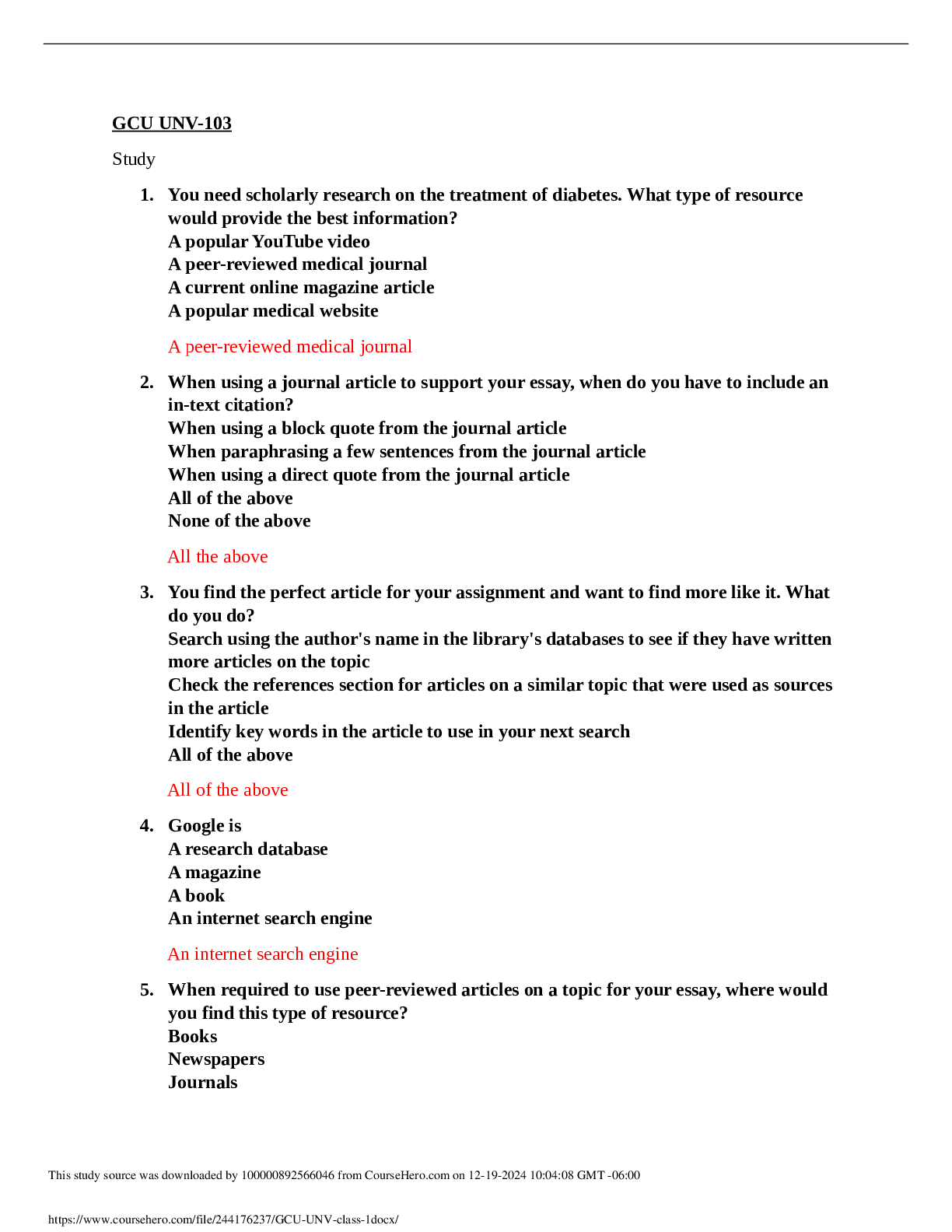

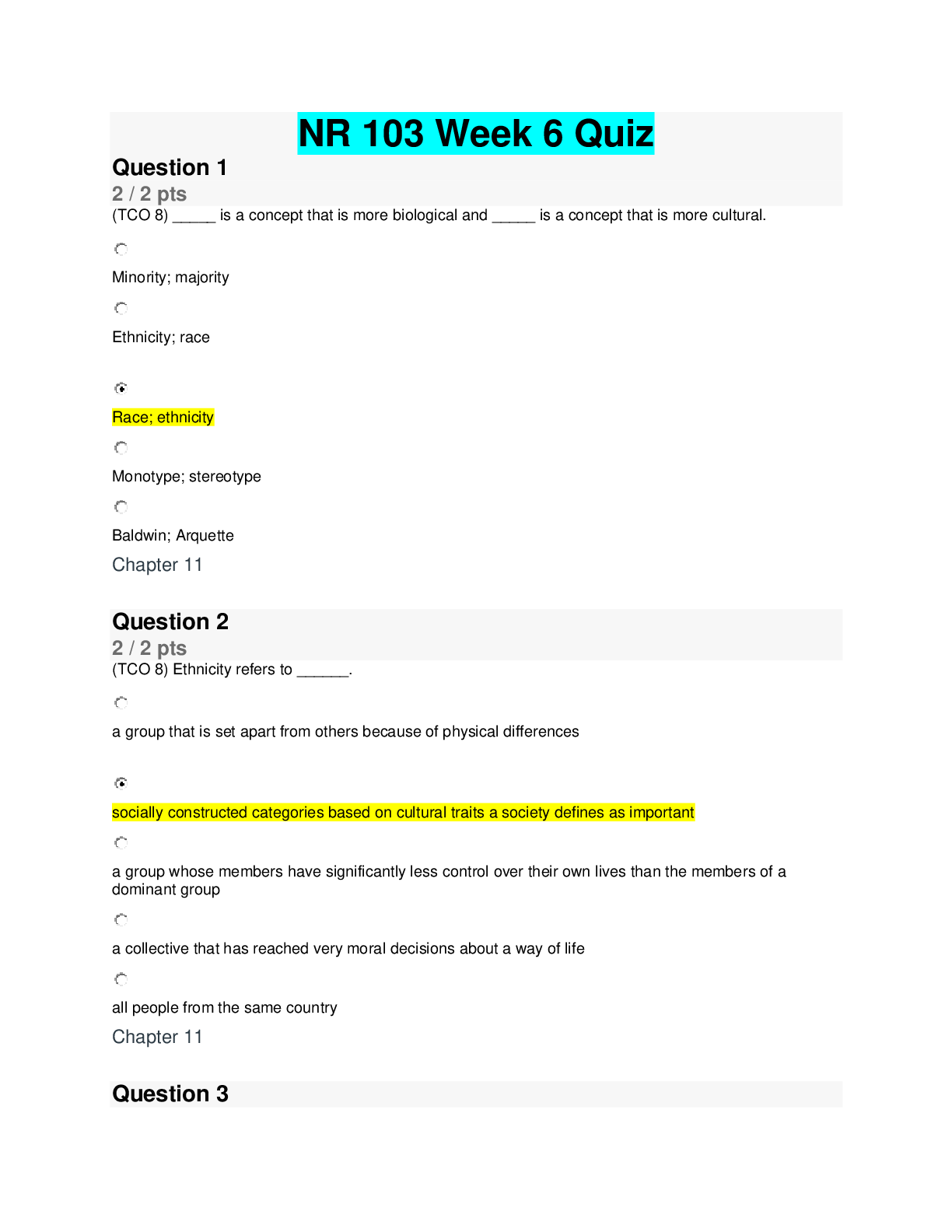


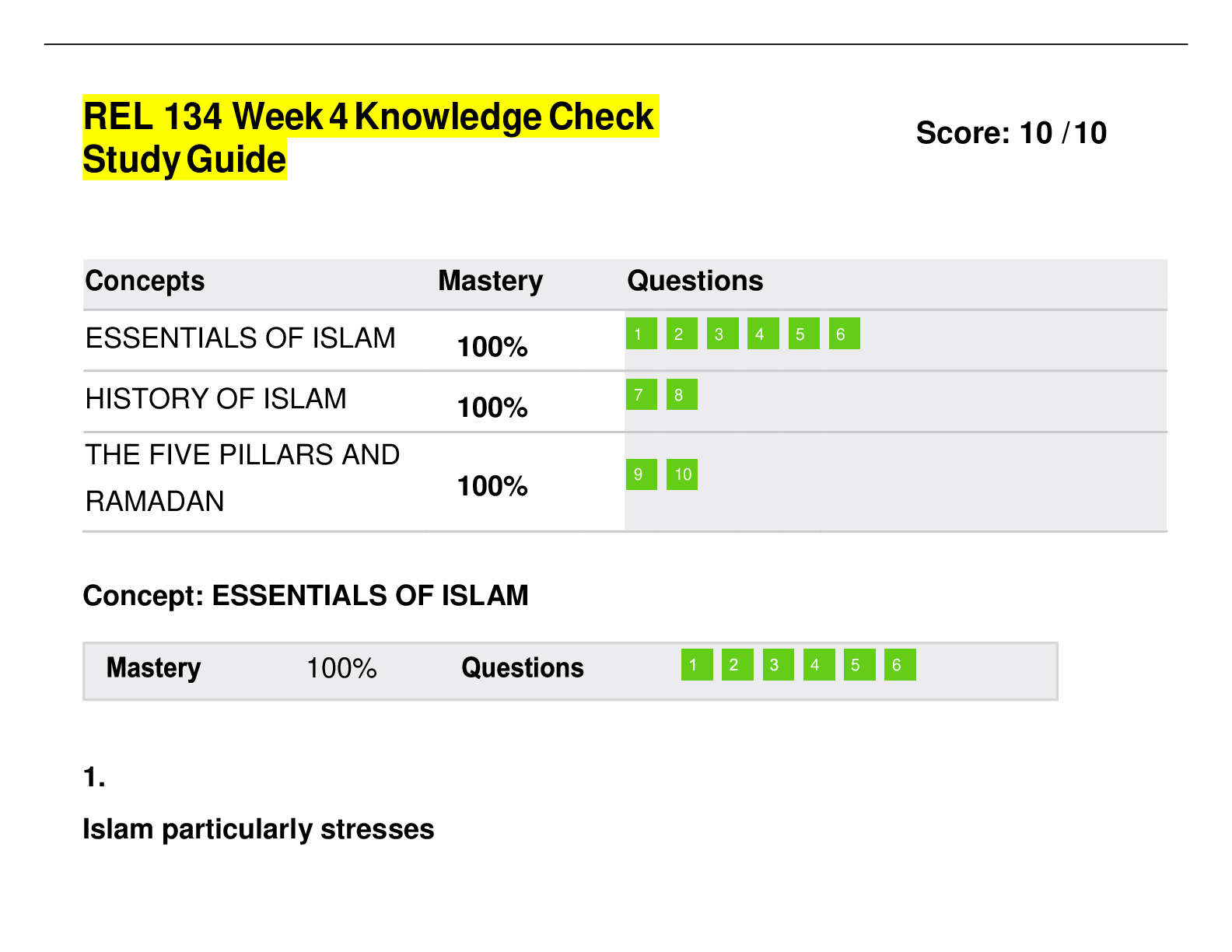
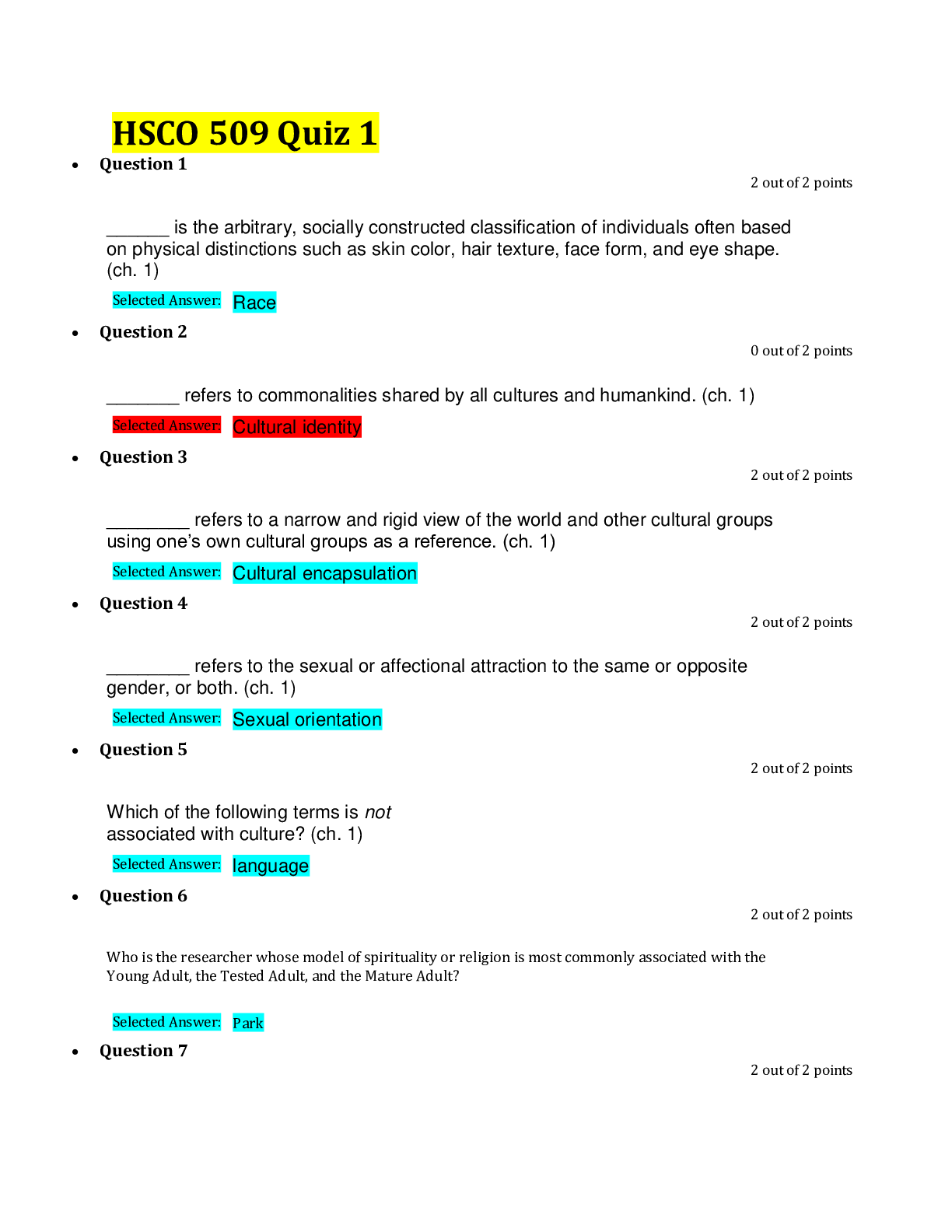
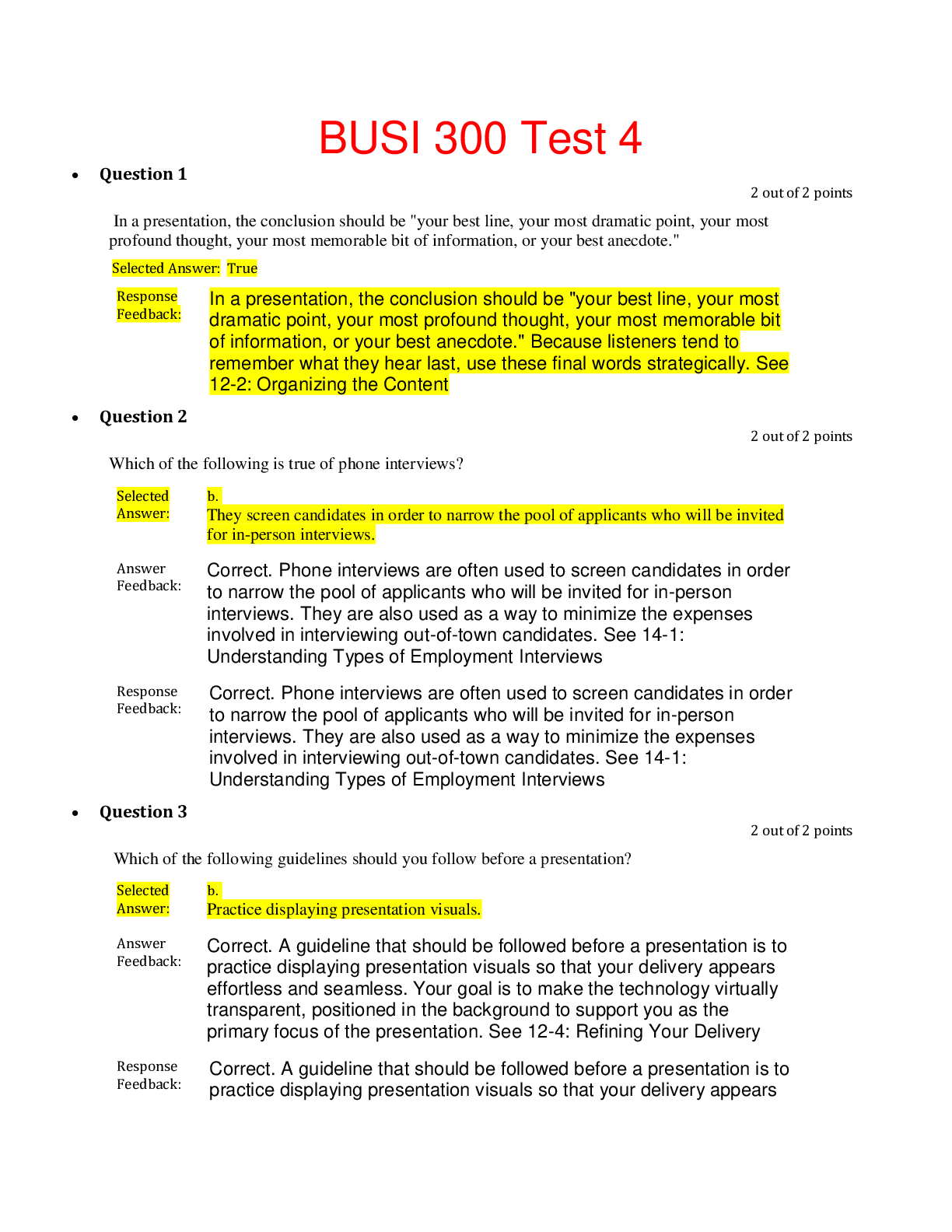







.png)

